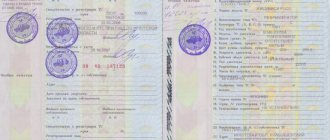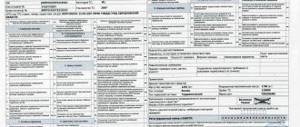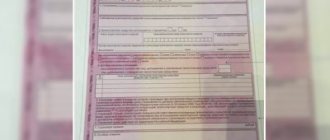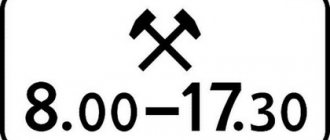What information does the PTS contain?
A vehicle passport is the main document of a car, containing detailed information about it. The passport is issued on a special strict reporting form and has a certain degree of protection in the form of special watermarks, holographic stickers and inscriptions.
The passport form is a sheet of A4 format, folded in half. The right side of the passport contains detailed information about the car. This part is filled out by a traffic police officer, vehicle manufacturer or customs service.
This part of the passport has 24 points with data:
- model, make of car;
- the country where the car was produced;
- car release date;
- body type;
- identification number (VIN code);
- name and details of the organization that prepared and issued the document.
The left half is divided into two parts. They contain information about all owners of the vehicle. The reverse side consists of four parts, also intended for entering data about the owners of the car. Thus, the maximum number of owners who can be entered on one form is 6.
You can see what a blank PTS form or a correctly executed document looks like in a photo on the Internet.
Saddle up early
It is advisable to ask for the vehicle’s vin code to be sent to you via SMS before inspecting the car. And through some service you will get acquainted with the exact data of the car. These data should not differ in any way from the data in the PTS. Now some sellers also indicate the VIN code in the ad.
On the State Traffic Safety Inspectorate website you can view the history of registration actions, check for search warrants, restrictions on registration, and recently they have been keeping records of vehicle participation in road accidents. Use various online resources to check your car. Here you can read about how to check a car for collateral and credit.
Do not hesitate to be annoying and meticulous; if the seller has nothing to hide, then he will allow all checks to be carried out.
I'm waiting for you on the pages of my blog again! Ask questions, I will look into them with pleasure.
Share this post
- Related Posts
- How a car dealership imposes extras on customers
- Is it possible to save on transport tax?
- Certificate of acceptance and transfer of the vehicle to the purchase and sale agreement
- Is it possible to refund VAT on a car purchase?
- Best time of year to buy a car
- We check the car for credit and collateral at the bank
What is the difference between an original PTS and a duplicate?
In certain situations, restoration or replacement of the registration certificate is required.
If the original is lost or damaged, as well as if the personal data of the car owner changes, a duplicate PTS is issued. This document is issued at the traffic police department upon presentation of a package of documents. The purpose of issuing a duplicate is to replace the original. This paper completely repeats the main content of the technical passport and has its own details. So what is the difference between a duplicate PTS and the original?
The main difference between this document and the original is the presence in the upper left part, in the “Special about. This paragraph also states the basis for issuing a copy and indicates that the registration certificate has been re-issued.
Duplicate or original?
A vehicle passport can be re-issued by traffic police departments in the following cases:
- in case of loss of the original document at the request of the owner of the car;
- in a situation where there are no free fields in the passport to make the necessary notes.
The duplicate fully retains the legal significance of the main PTS and does not differ from it in appearance. When making a copy, be sure to put a corresponding stamp in the “Special notes” field.
The danger of purchasing a car with a duplicate title may lie in wait for the buyer if fraudulent schemes are used:
- Sale of a car that is the subject of a bank pledge - when an unscrupulous seller, who previously took out a car on credit, illegally sells the vehicle.
After purchasing a credit car, the new owner will certainly face claims from the bank, which will have to be resolved in court. - Selling a stolen car is when swindlers make a fake title, altering the numbers on the car frame.
Important! A duplicate PTS can be issued for a scrapped vehicle that cannot be legally registered with the traffic police.
In what cases is a duplicate PTS issued?
The grounds for issuing it are few.
There are only a few reasons allowed for the re-issuance of PTS:
- loss of PTS;
- damage to a document;
- All lines on the PTS form are filled in, and there is no way to enter the new owner of the car.
Also, a duplicate PTS is issued to the car owner due to the need to make changes.
They are necessary to increase the relevance of information and concern only three points:
- Place of registration of the owner of the vehicle.
- Personal information of the car owner.
- Information about the vehicle.
These situations are not formal grounds for issuing a duplicate. But experienced motorists in such cases advise the owner to make changes to the current title.
PTS duplicate - what does it mean?
First, let's figure out what a duplicate PTS means and why does it appear on a car?
As you know, a PTS is a car’s passport, its main document. Among other things, the passport reflects registration records with the traffic police. But what to do when the seats in the PTS run out , because there are only six of them? Or what to do if this important document is lost, or if it simply gets torn? This doesn't happen often, but it does happen.
Since 2021, in this situation, an electronic PTS is issued, but before, the traffic police issued a duplicate PTS. In fact, this is a regular PTS form, with its own unique number. It completely replaces the original document and allows you to perform all the same operations with the car. However, knowledgeable people try to avoid duplicates when buying a car . Why?
The procedure for obtaining a duplicate PTS
You can receive a duplicate in 1 day. If additional checks are carried out, the registration period may increase to 30 days.
To re-receive a lost or replace a valid registration certificate, the following data is required:
- passport;
- documents confirming the purchase of the vehicle;
- certificate confirming ownership of the vehicle;
- explanatory note (if lost);
- MTPL insurance policy;
- receipt of payment of state duty.
After providing all the necessary information to the MREO, you need to go through the vehicle inspection procedure. If the registration certificate is lost, the inspector will inspect the car and sign the application. All documents are handed over to the traffic police officer.
Duplicate PTS - what to be afraid of?
But what if you come across a duplicate PTS – what should you be afraid of when buying a car? The main disadvantage of a car with a duplicate is that the original may fall into the hands of third parties. Therefore, when dealing with a duplicate, there is always a chance of losing the car.
How it works? For example, it could be a collateral car. The title is kept by the pledge holder, and the enterprising owner receives a duplicate from the traffic police and sells the car. For the buyer, this situation is a stalemate. If he did not take care of a notarized extract from the register of pledges, he will not be able to save the car.
What else you should be afraid of is that the original PTS will be used according to one of the criminal schemes . If a real title is sold on the black market, a car with altered license plates will be made to match it. As soon as the double “surfaces”, a criminal case is initiated. As a result, the investigation may initiate an examination of the markings of both cars, including chemical etching of VIN numbers. In a word, this is a real hemorrhage, and the price of the car will definitely not increase after such an examination.
But the main problem with the duplicate is that it hides the entire backstory of the car . To be honest, our car’s history is opaque even with the original title, but at least you can see there:
1) History of the owners. Are there any legal entities among them? 2) Whether the car was retained by the owners for at least a couple of years. If it’s less, it’s unlikely that the car was taken care of. 3) Did the first owner (dealer) register the car? If you installed it, it means the car was driven, that is, it was used for a test drive or as a replacement. 4) It happens the other way around, when a meticulous and unsophisticated owner uses up a lot of space in the PTS, changing the STS every time the registration changes. In fact, the car, being in the same hands, is usually preserved much better.
Roughly speaking, a duplicate is a hat. It practically erases the history of the car, which is why, by the way, it is deliberately obtained when it is necessary to hide the past of the car.
How to distinguish a fake from the original
Unscrupulous sellers, for the purpose of deception, use a fake vehicle passport.
Modern fakes are practically no different from the original. How can a simple car owner, using available means, distinguish a real document from a “fake” paper? To examine the document you will need an ordinary flashlight and a magnifying glass. What should you pay attention to?
- First of all, you need to pay attention to the originality of the document.
- If the car seller has a duplicate on hand, you need to find out why it was issued.
- The vehicle passport is issued on a blue form measuring 20x31, which is printed on special paper. It feels denser to the touch, differs significantly from a simple one and looks more like a banknote.
- The RUS watermarks and stars should be visible in the light of the document.
- The hologram must have clear boundaries.
- The signature “PTS” should be located above the hologram in the corner. You can see it in the upper left corner by tilting the document about 30 degrees and highlighting it with a flashlight.
Upon detailed inspection of the document with a magnifying glass, you can see the special inscription “vehicle passport”. It is located on the line of the inner fold and forms a dark unbroken stripe.
The main inscription: “Vehicle Passport” sticks out a little. This can be felt by palpation.
The date of production of the form is indicated in the left corner of the bottom of the form. If the form was produced much earlier than the PTS was issued, then this is a fake.
The main degrees of protection of the PTS form:
- Letterpress printing of the passport number, i.e. depression in places of the image: clear and even edges of the strokes, thickening of the dye along the edges of the strokes, which gives the feeling of edges.
- Special paper is used; it has a certain texture and a specific pattern, which does not lose clarity when viewed closely through a magnifying glass.
- Infrared marks (elements that disappear in the infrared glow) are applied. When exposed to infrared light, the machine in the upper right corner of the back of the form disappears. On the spread, the typewriter in the upper left corner is barely visible, and the inscription “special marks” disappears.
- 3D printing is also used. The words “vehicle passport” are embossed to the touch. On the reverse side there is a sign in the shape of a flower; in addition to being voluminous, it also changes color when tilted.
- Ultraviolet tags that glow when illuminated by an ultraviolet lamp.
- The hologram is round or in the form of a strip (on old PTS). Clear and easy to read. This is the main protection, it is difficult to fake with high definition. There should be no sticker feel to the touch; the hologram and the form are one whole. The hologram depicts a traffic police car with the inscription “RUSSIA RUSSIA” on the windshield
- Water marks. When the PTS form is scanned, a three-dimensional (volumetric) watermark “RUS” is visible on it. X-raying the form can also reveal “washed out” data.
What should you be wary of?
You need to be careful when buying a used car.
When checking the original passport or its copy before concluding a contract, you should also pay attention to these signs:
- too many previous car owners;
- car ownership periods are too short;
- remote registration region;
- the seller is in a hurry and nervous, rushing to conclude a deal as quickly as possible;
- undervalued car;
- The document is too neat, looks like it was reprinted.
If, when checking the document, at least one of the points was identified, there is no need to immediately refuse the purchase. It just takes more time to check the car owner's documents.
How to distinguish an original PTS from a duplicate
In appearance and information placed in the document, the duplicate PTS is completely identical to the original.
This is a document that is issued in a uniform form throughout Russia. Forms for it are printed under strict state control, on special paper with an identifying background pattern and watermarks. The only difference is that in the “Special notes” column a rectangular stamp “DUPLICATE” is placed. After receiving a duplicate, the original registration certificate loses its validity, and even if you find it later, you can no longer use it instead of a duplicate. In terms of its legal force, the duplicate completely replaces the original and can be used in all situations in which the presentation of a PTS is required.
What they look like
The purchase and sale of a car, registration of compulsory motor liability insurance and other legal actions are impossible without a title. This is the main document for the vehicle, containing all the information related to the car.
It consists of 24 columns, which indicate:
- Vin number of the car body, consisting of 17 digits (indicated in several parts of the body, so you need to compare all the inscriptions).
- Engine parameters: manufacturer, date of manufacture, volume, type, code.
- Car make, color and type.
- Country of origin of the vehicle and information about the manufacturer.
- Year of issue.
- Special notes.
- Information about the owner (including previous ones), etc.
A vehicle passport has several security mechanisms that make it difficult to forge:
- hologram on the first sheet;
- water marks;
- voluminous text that changes color depending on the viewing angle;
- manufacturer's or customs seal.
The duplicate is issued on the same form as the original, it has the same security marks. The only difference from the original PTS will be the presence of a corresponding stamp and a later date of issue of the document.










